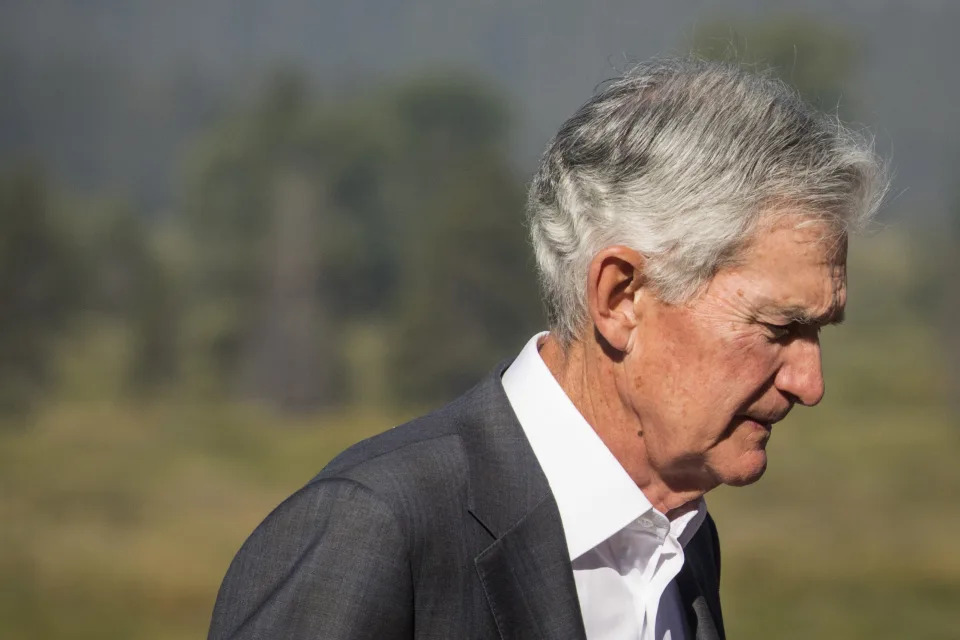This week in Bidenomics: It’s about time
Rejoice! After 13 months of speculation and trillions of dollars in financial market bets, the Federal Reserve is finally going to execute a tiny interest rate cut.
At the Fed’s annual Jackson Hole policyfest, central bank Chair Jay Powell finally uttered the magic words: “The time has come for policy to adjust,” Powell said . “The direction of travel is clear, and the timing and pace of rate cuts will depend on incoming data.” If that needs translating, the “direction of travel” means rates will go down, and the reference to incoming data means the Fed will cut gradually unless a recession starts to seem likely, in which case it will cut aggressively.
Markets knew this was coming, but it’s still a crucial pivot point that could help boost consumer attitudes in the run-up to the November election and add to confidence that the high inflation of the last three years is finally over and done with.
How we got here: When Joe Biden took office in January 2021, inflation was a negligible 1.4% and the Fed’s short-term interest rates were close to zero. As we know now, a combination of factors including COVID-era disruptions, massive shifts in consumer demand, trillions of dollars in fiscal stimulus, and Russia’s 2022 invasion of Ukraine generated a nasty bout of inflation that peaked at 9% in June of 2022.
The Fed’s main job is fighting inflation, usually by raising interest rates. But the Fed got a late start this time around. It didn’t start hiking until March of 2022, when inflation was already at 8.5%. That late start forced the Fed to hike at one of the fastest paces ever, with 11 hikes that brought short-term rates to 5.5%. That pushed rates on mortgages, car loans, and every other type of borrowing abruptly higher, making anything that required financing suddenly more expensive.
While all this was going on, President Joe Biden’s approval rating sank from a high of 55% to the 40% range, where it’s been stuck for more than two years. Rates went up while inflation was still high, a shock for consumers who had enjoyed low rates and low inflation for more than a decade. Inflation has been falling since the middle of 2022, but rates haven't been, and voters’ dismal views of Biden contributed to his July decision to withdraw from the 2024 presidential race.
Drop Rick Newman a note , follow him on X , or sign up for his newsletter .
The last Fed rate hike was in July of 2023. Since then, it’s been a waiting game. The Fed wants to feel sure it has vanquished inflation before reversing course and cutting rates. Investors have been scrutinizing every byte of inflation data for hints on what the Fed might do. There have been market rallies and market sell-offs based on tidbits suggesting inflation is falling faster or slower than expected, which in turn suggests the Fed might cut sooner or later. Every time a Fed policymaker utters a peep, investors tune out everything else and crank the volume.
The suspense has now ended. Powell made clear the Fed will start cutting rates at its next policy meeting, which concludes Sept. 17. It will be a quarter- point cut, unless the economy suddenly turns south, which would bring a half-point cut.
The next meeting after that isn’t until Nov. 6, just after Election Day. So voters won’t notice big rate reductions by the time they vote for the next president. They will, however, know that rates are finally on the way down, which could make people planning to buy a house or car a little more optimistic.
If this had all happened six months sooner, Biden’s reelection odds might have looked better before he bailed out in July. But it’s coming too late to help Biden, and besides, the Fed can’t lower Biden’s age, which is his other big liability.
Will Fed rate cuts help Vice President Kamala Harris, now the official Democratic presidential nominee? It’s possible. As Biden’s No. 2, Harris carries some of the same baggage as Biden when it comes to the high cost of groceries and housing. She’s clearly trying to break with Biden by calling for new ways to lower food and housing costs . Her approval ratings are 6 to 8 points higher than Biden’s, so maybe it’s working.

As it stands now, the election outcome is likely to be remarkably close, with Harris and her Republican opponent, Donald Trump, scrounging for every tiny edge. If inflation keeps dropping and the job market holds up, rate cuts won’t be a negative for Harris, and they could be a slight positive.
As for Biden, once his presidency is over, it may become clear that inflation was relatively transitory after all, and back to normal by the end of his term. History may be kinder to him than the current electorate. The ultimate test may be whether they choose to make Kamala Harris his successor.
Rick Newman is a senior columnist for Yahoo Finance . Follow him on X at @rickjnewman .
.




